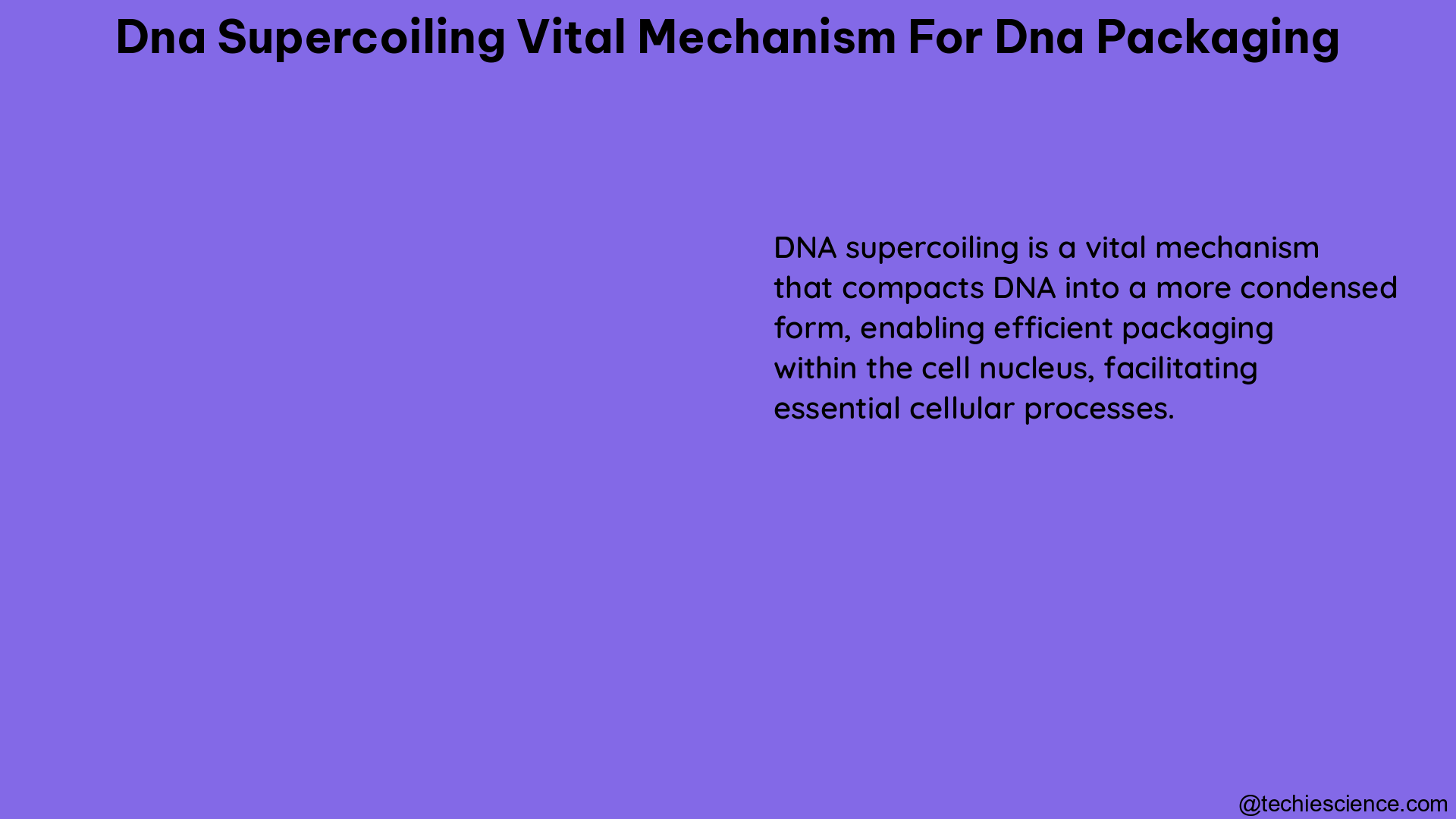DNA supercoiling is a fundamental process that plays a crucial role in the efficient packaging and organization of genetic material within the confined space of a cell. This intricate mechanism involves the further coiling of the DNA double helix upon itself, introducing structural strain and enabling the DNA to be compacted into a more compact form. Understanding the intricacies of DNA supercoiling is essential for comprehending the complex mechanisms underlying DNA replication, transcription, and other vital cellular processes.
Quantifying DNA Supercoiling: Linking Number and Superhelical Density
The degree of DNA supercoiling can be quantified using two key parameters: the linking number and the superhelical density.
Linking Number (Lk)
The linking number represents the number of times one strand of the DNA double helix pierces the other strand. In a relaxed, unstrained DNA molecule, the linking number is equal to the number of base pairs divided by the helical repeat, which is typically around 10.5 base pairs per turn.
Superhelical Density (σ)
The superhelical density, denoted as σ, expresses the change in linking number relative to the relaxed DNA molecule. It is calculated as the difference between the actual linking number (Lk) and the linking number of the relaxed DNA (Lk₀), divided by the linking number of the relaxed DNA (Lk₀).
Mathematically, the superhelical density can be represented as:
σ = (Lk – Lk₀) / Lk₀
Cellular DNA typically exhibits a superhelical density ranging from -0.05 to -0.07, indicating a 5-7% underwinding of the DNA double helix, which introduces negative supercoiling.
The Role of Negative Supercoiling in DNA Recombination

Negative supercoiling plays a crucial role in the resolution reaction, a key step in DNA recombination. This has been demonstrated in a study on the Salmonella enterica bacterium.
Synapse Formation
The study found that negative supercoiling promotes the synapse of two 114 base pair Res sites, forming an interwound, three-noded braid of negatively supercoiled duplex DNA. This synapse is a necessary prerequisite for the recombination process to occur.
Rotation of Protein-DNA Complex
Negative supercoiling also drives the rotation of the protein-DNA complex, completing a round of phosphodiester bond exchanges between the four participating DNA strands. This rotation is essential for the resolution reaction to be carried out successfully.
Diffusible Supercoiling and DNA Gyrase
Diffusible supercoiling, which is the component that promotes recombination, is generated and maintained at defined levels by the enzyme DNA gyrase. This enzyme introduces negative supercoils into the DNA, ensuring the appropriate degree of supercoiling for the resolution reaction to proceed efficiently.
Visualizing Supercoiled DNA: Plectonemes and Sequence-Dependent Structures
Researchers have employed a single-molecule technique called ISD (intercalation-induced supercoiling of DNA) to directly visualize the structures formed by supercoiled DNA, known as plectonemes.
Plectoneme Formation and DNA Sequence
The experiments have shown that the DNA sequence directly encodes the structure of supercoiled DNA by pinning plectonemes at specific sequences. The local intrinsic curvature of the DNA molecule determines the relative stability of plectonemes at different sequences.
Plectoneme Localization and Promoter Regions
Analysis of several prokaryotic genomes has revealed that plectonemes tend to localize directly upstream of promoter regions. This observation has been experimentally confirmed for selected promoter sequences, suggesting a potential role of supercoiling in the regulation of gene expression.
Factors Influencing DNA Supercoiling
DNA supercoiling is influenced by various factors, including:
-
DNA Topology: The inherent topology of the DNA molecule, such as its helical twist and writhe, plays a crucial role in determining the degree of supercoiling.
-
Cellular Enzymes: Enzymes like DNA gyrase and topoisomerases are responsible for introducing, maintaining, and resolving supercoils in the DNA.
-
Environmental Conditions: Environmental factors, such as temperature, pH, and ionic concentrations, can affect the stability and dynamics of supercoiled DNA structures.
-
Protein Interactions: Binding of regulatory proteins to the DNA can influence the degree of supercoiling, either by directly altering the DNA topology or by recruiting enzymes that modulate supercoiling.
-
Transcription and Replication: The processes of transcription and DNA replication can generate torsional stress, leading to the formation of supercoiled structures.
Understanding these factors and their interplay is crucial for unraveling the complex mechanisms underlying DNA supercoiling and its role in various cellular processes.
Implications of DNA Supercoiling
The efficient packaging of DNA through supercoiling has far-reaching implications in various aspects of cellular function:
-
Genome Organization: Supercoiling allows the compact storage of genetic material within the limited space of the cell, enabling the precise spatial organization of the genome.
-
Gene Regulation: Supercoiling can influence the accessibility of DNA to regulatory proteins, thereby modulating gene expression patterns.
-
DNA Replication and Transcription: Supercoiling can facilitate the unwinding of the DNA double helix, which is essential for the progression of replication and transcription machineries.
-
DNA Repair: Supercoiling can affect the accessibility of DNA repair enzymes to damaged sites, influencing the efficiency of DNA repair mechanisms.
-
Chromosome Segregation: Supercoiling plays a crucial role in the proper segregation of chromosomes during cell division, ensuring the accurate distribution of genetic material to daughter cells.
Understanding the intricate mechanisms of DNA supercoiling is not only essential for unraveling the fundamental principles of cellular biology but also has important implications in fields such as biotechnology, medicine, and evolutionary biology.
Conclusion
DNA supercoiling is a vital mechanism that enables the efficient packaging and organization of genetic material within the confined space of a cell. By quantifying the degree of supercoiling through the linking number and superhelical density, researchers have gained valuable insights into the role of negative supercoiling in DNA recombination and the sequence-dependent structures formed by supercoiled DNA, known as plectonemes. The factors influencing DNA supercoiling and the far-reaching implications of this process in various cellular functions highlight the importance of continued research in this field. As our understanding of DNA supercoiling deepens, it will undoubtedly lead to advancements in diverse areas of biology and beyond.
References
- Travers, A., & Muskhelishvili, G. (2015). Bacterial chromatin. Biochimica et Biophysica Acta (BBA) – Gene Regulatory Mechanisms, 1859(3), 368-378. doi:10.1016/j.bbagrm.2015.09.004
- Fogg, J. M., Kolmakova, N., Rees, I., Magonov, S., Hansma, H., Perona, J. J., & Zechiedrich, E. L. (2006). Exploring writhe in supercoiled minicircle DNA. Journal of Physics: Condensed Matter, 18(14), S145-S159. doi:10.1088/0953-8984/18/14/s13
- Koster, D. A., Croquette, V., Dekker, C., Shuman, S., & Dekker, N. H. (2005). Friction and torque govern the relaxation of DNA supercoils by eukaryotic topoisomerase IB. Nature, 434(7033), 671-674. doi:10.1038/nature03395
- Drlica, K. (1992). Control of bacterial DNA supercoiling. Molecular Microbiology, 6(4), 425-433. doi:10.1111/j.1365-2958.1992.tb01487.x
- Bates, A. D., & Maxwell, A. (2005). DNA Topology. Oxford University Press.

I am Abdullah Arsalan , Completed my PhD in Biotechnology. I have 7 years of research experience. I have published 6 papers so far in the journals of international repute with an average impact factor of 4.5 and few more are in consideration. I have presented research papers in various national and international conferences. My subject area of interest is biotechnology and biochemistry with special emphasis on Protein chemistry, enzymology, immunology, biophysical techniques and molecular biology.